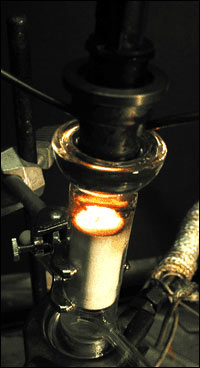Researchers at the University of Minnesota have developed a new, carbon-neutral way to convert vegetable-based fuels to syngas, a breakthrough that could allow producers to power hydrogen fuel cells or create a replacement for America's dwindling supplies of natural gas, all without relying on fossil fuels.
We've all had the experience of watching cooking oil smoke once a pan reaches a certain temperature, and suffered the indignity of having to scrub off the caked-on, carbonized gunk that results. A similar problem plagued researchers trying to convert biofuels: When heated, they clogged the pores of the catalyst used to transform them into syngas, which is a mixture of gases that include hydrogen, carbon monoxide and carbon dioxide.
The breakthrough came with the perfection of a technique that heats fuel to a temperature so hot that the smoking reaction is bypassed, said Bradon Dreyer, a chemical engineering and materials science graduate student at the University of Minnesota.
Dreyer and his colleagues built a reactor capable of producing hydrogen from soybean oil, biodiesel or sugar water without any of the buildup that would have resulted from a conventional process. To get the reactor warmed up, the researchers ignited a mixture of methane and oxygen in order to bring the catalyst to a searing 1,000 degrees Fahrenheit.
Addressing concerns about keeping the process carbon-neutral, Paul Dauenhauer, another graduate student working on the project, notes that while methane is a fossil fuel, there are other ways to heat the catalyst that don't involve burning petrochemicals. What's more, once the reaction is running, it's self-sustaining, and methane and oxygen are no longer required.
A fuel injector like those used in a car atomized the biofuels into tiny droplets that landed on a hot rhodium-cerium catalyst, which converted the fuel to syngas. This reaction released energy and heated the catalyst. The heat and ratio of carbon and oxygen in the reaction kept the buildup from sticking to the catalyst. For each type of biofuel, nearly all the fuel was converted and about 70 percent of the hydrogen bound up in the fuel molecules was given off as gas, the researchers report in this week's Science. "We find we reach the theoretical maximum," says Dauenhauer.
The whole reaction takes less than 50 milliseconds. "Faster means smaller," says Dreyer, who predicts that because of its speed, their reactor can be scaled down and remain efficient. Dreyer also notes that their reactor could work on other fuels, including used cooking oil. Best of all, no more carbon comes out of their system than went into it.

